|
Diary of a flying trip
November 2004
|
Back to home page
click on any image
for a larger version |
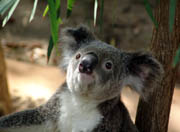 |
Australia. Itís huge. Itís far away. Itís a bit of everything and a
lot of nothing. Itís been described as being the most infertile and
climatically hostile of all inhabited continents. It has sharks,
crocodiles and poisonous snakes, lethal jellyfish and even seashells
that can kill. This is the land of vegemite* and Crocodile Dundee. How
can one not be fascinated?
*
If youíre not familiar with Ďvegemiteí, itís a uniquely Australian treat
that I was told I would have to develop a taste for. The jar describes
it as concentrated yeast extract. I guess thatís what it tastes like.
I decide that Iím on vacation and if Iím going to work at anything Ė Iíd
rather work on a nice Australian Shiraz from the Barossa Valley.
Weíve signed up for a 16 day flying safari with
Air
Safaris International.
We are part of a group of 3 planes. My husband, Rob, a private pilot,
will be piloting a Cessna 172 R. A professional pilot will fly another
couple, and Clare (our tour director) will fly in the lead plane with
another professional pilot.
Day 1 to Day 2 Brisbane
We meet our group in Brisbane. After over 25 hours in the air and,
including layovers, almost 40 hours of travel, Brisbane is a welcome
relief. Itís a pretty city, and for those of us coming from the north
in the dismal month of November, itís a taste of summer, graced by
flowers in bloom, touched by sunshine, and dotted with open air
restaurants and patios. Itís a city like all cities, with a morning
rush hour and traffic jams and the hum of business and life. We stay at
the Rydges Southbank, just steps away from the river that runs through
the city, the walking paths that run along it, and a public Ďbeachí
swimming pool. For those wanting to test their luck, the Casino is just
on the other side of the river, accessible by a nearby bridge, and just
beyond that, downtown Brisbane.
|
Already we sense a difference. A slower pace perhaps? A life less
hurried? The entire city (and weíve been told the entire country) shuts
down for an afternoon as the Melbourne Cup is run. The Melbourne Cup is
a horse race, and itís over in whatÖ a minute? Two? Yet it becomes an
afternoon event with betting rampant and people dressed in their summer
finery convening at clubs and bars to watch. Later in the day as the
revelers find their way home, getting a cab is virtually impossible.
We spend two days in Brisbane, as the pilots get acquainted with their
planes and the rules and regulations for flying in Australia. We
passengers attend a safety briefing one morning, and have the rest of
the time free to explore Brisbane. A city is just a city though, and as
lovely as it is, itís just a part of the bigger picture that is
Australia. Iím eager to move on. |
 |
Day 3 Brisbane
to Charleville

|
We leave from the Royal Queensland Aero
Club. At first, what we see below us is little different from
home. Agricultural fields which seem like a cross between
Arizona and the Canadian prairies. Roads. Houses. Slowly
though, the landscape changes and by the time we reach our first
overnight stop, Charleville,
we are beginning to see the terra cotta colours and red soil that will
become so familiar. |
 |
|
Charleville, our first taste of the outback, is a town of 3,600 where
pet kangaroos lounge on front lawns. Here we get our first real
appreciation for how desperately dry the outback can be. In 1902 the
town, suffering from an extended drought, purchased a number of ďvortex
cannonsĒ to fire explosives into the clouds and, the theory was, cause
it to rain. They failed. Rumor has it that the inventor was run out of
town. You have to need rain very, very badly to come up with a plan
like this.
Of course, that was years ago. As we arrive, so does the rain. It
pours in the evening and all sorts of living things are scampering,
hopping and crawling about. Insects beat against the windows, huge green
frogs lounge by our door, and even a pale lizard appears to have moved
into our room. We awake to more rain. Clare (the tour organizer) is
aging before our eyes. We canít fly in the rain and with a tightly
booked schedule, he sees his well made plans going down the drain (so to
speak). I canít help but find some humour in it. Rain seems to follow
Rob and I on our vacations, why should we expect anything different from
the outback? The rain stops after breakfast though, and soon the clouds
begin to break. We are on our way again!
|
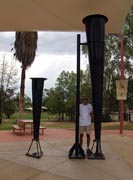 |
Day 4 Charleville to Birdsville
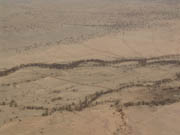 From the air, we can
see the landscape becoming more desolate. The snaking lines of trees
mark the river beds where the water runs when it rains. Itís all dry
now, as if the rain of last night never happened, and the tree lines run
like veins across the otherwise empty land. We occasionally see a road,
not a lot of traffic, but sometimes a Ďroad trainí (a transport truck
with numerous trailers in tow) stirring up clouds of red dust. From the air, we can
see the landscape becoming more desolate. The snaking lines of trees
mark the river beds where the water runs when it rains. Itís all dry
now, as if the rain of last night never happened, and the tree lines run
like veins across the otherwise empty land. We occasionally see a road,
not a lot of traffic, but sometimes a Ďroad trainí (a transport truck
with numerous trailers in tow) stirring up clouds of red dust.
Our next stop is
Birdsville, the dead heart of Australia, the most remote town in
Queensland. It marks the northern end of the 541 km Birdsville track,
one of Australiaís best-known driving adventures. To bring into
perspective just how remote, desolate and unforgiving this land is,
about 100 km down the Birdsville Track is a simple memorial to the Page
family who in 1963, after their car had broken down, tried to walk to
safety. All five members of the family died. Just prior to our visit, a
tourist on a motorcycle was stranded. He consumed all of his emergency
water on the first day. There is not a lot of traffic out here. When
another vehicle found him two days later, he was barely alive.
|
|
We go for a walk around town and find that there is nothing here. Well,
almost nothing. There is a hotel, a gas station, a general store, and
(supposedly) a post office and police station, though neither one of us
remembers seeing the post office or police station. The sun beats down
on us and except for the other couple from our safari, we see no one
else walking. There is a museum/visitor information centre, staffed by
a couple of young women who try to look too busy to say Ďhií. Perhaps
we woke them from a lazy afternoon nap. Perhaps a tour bus has just
passed through and they are recovering from seeing more than one tourist
a day. Or maybe, if you live in the most remote town in Queensland,
youíve earned the right to treat tourists with some disdain. Who knows?
| Our
walk brings us to the edge of town where steaming water comes out of the
earth. The Great Artesian Basin lies under about one fifth of
Australia, including Birdsville. Itís one of the
largest areas of
artesian water in the world. In Birdsville the water is almost boiling
(itís certainly steaming) when it comes out of the ground and it has to
be cooled before distribution. Turned on full, the cold-water tap
provides luke warm water. The hot water is also used to generate
electricity, providing power for the entire town.
The town is so bleak that itís appealing. The hotel is also the bar,
and the restaurant, and tomorrow itís going to be the church. Itís
being decorated for a Christening, after which the parents of the child
have decided to get married. An exciting day is coming up for Birdsville.
|
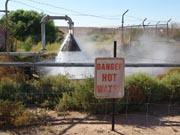 |
 Itís Friday night and the bar is busy. The street outside is lined
with 4x4ís (OK, I count 7, but in this town that seems like a lot).
You can tell that most of the patrons are regulars, as they fall into
easy conversation. Dozens of hats adorn one wall of the bar. If you
stay in the town for one whole year without leaving, you get the honour
of hanging your hat on the wall. The other wall has fewer hats. If you
die in the town, and your hat is on the first wall, itís then moved to
the second wall. Itís Friday night and the bar is busy. The street outside is lined
with 4x4ís (OK, I count 7, but in this town that seems like a lot).
You can tell that most of the patrons are regulars, as they fall into
easy conversation. Dozens of hats adorn one wall of the bar. If you
stay in the town for one whole year without leaving, you get the honour
of hanging your hat on the wall. The other wall has fewer hats. If you
die in the town, and your hat is on the first wall, itís then moved to
the second wall. |
 |
|
Every September, the population of this quiet town increases from 100
to 5,000 as people converge for the famous Birdsville horse races.
Itís difficult to imagine where they stay and
how the facilities of the town support them, but the races occur
annually so itís clear that it can be done.
The hotel room is
basic, but it does have air conditioning (thank goodness) and itís
perfect for this town. We are happy to see that we have a room lizard
again.
Day 5 Birdsville to Coober Pedy
| We set out the next
day, flying across the vast
Simpson Desert
National Park. I called Birdsville desolate. Itís hard to find an
appropriate word for the desert. We could be on another planet. The
desert stretches as far as the eye can see and our vision starts to play
tricks with us as we stare at the horizon. This day of flying takes us
past Lake Eyre, famous for being the saltiest lake in
Australia
(some say itís the saltiest lake in the world). It has only been full
six times since the Europeans found it. We donít see any water, just
miles and miles of white salt. |
 |
|
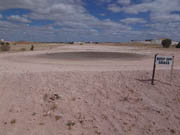
Coober Pedy golf course |
Our next stop is
Coober Pedy, the opal capital of Australia.
Australia
continues to amaze me. Just when I thought Iíd seen enough that was
desolate and bleak we arrive in Coober Pedy. From the air, the stark
dry landscape is dotted by what could be giant anthills. Not so. What
we see are the tailings of hundreds (thousands?) of mineshafts that have
been drilled straight into the ground.
The climate is brutal here. In
summer, the temperature can rise to 50 degrees C (that's about 122 F). When the makers of
Mad Max III were looking for a hostile environment for the film, they
chose Coober Pedy. |
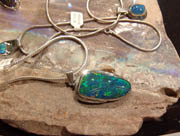 |
How do you live in a place like this?
The
inhabitants of Coober Pedy have found a solution. Theyíve moved
underground. About 60% of the 4000 people living in and around the town
live in dwellings carved into hillsides. Even the church is
underground. Our hotel, the Desert Cave has underground rooms that are
surprising cozy, well lit, and not at all claustrophobic. The streets
are lined with opal shops and the deals are amazing. Rob and I try our
luck at fossicing (looking for opals in huge piles of tailings
accessible to the public) but fail rather dismally. Fortunes are made
and lost in this town, but our fortune will have to be made elsewhere. |
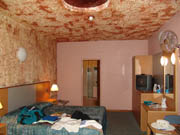
Underground hotel room
|
Day 6 Coober Pedy to Ayers Rock (Uluru)
& Day 7 Ayers Rock
| The next day has us
flying again. We fall easily into the daily rhythm of getting up early,
flying for 4 or 5 hours, landing, booking into the hotel and then taking
a tour of the town. The planning is all done for us, the hotel shuttles
show up out of nowhere, the hotels are always ready, the tours
arranged. Itís a very comfortable and relaxing way to travel.
The landscape that
we fly over is familiar to us now. Outstations (the equivalent to our
ranches) are few and far between. There is so little out here that
almost every outstation earns a place name on our map. Amazingly
straight fence lines and small dirt roads stretch out towards the
horizon. They seem to connect nothing to nothing. |
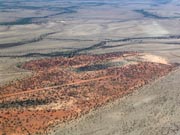 |
|
Our next stop is the most famous of our destinations Ė Uluru (Ayers
Rock). Itís a clear day for flying and we can see worldís largest
monolith from 100 miles away. The airport is modern and prepared to
accommodate thousands of tourists. Our hotel, Sails in the Desert is by
far the most luxurious place weíve stayed so far. The green manicured
lawns and inviting pool are a stark contrast the arid red landscape just
beyond the resort. Our first evening has us dining in the desert under
the stars, sipping wine and listening to a presentation about the night
sky. Itís a truly lovely evening
and a very polished event. Practice makes perfect. They know how to
please tourists at Uluru. |
 |
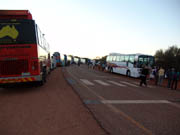 |
The next morning Rob and I are up at 4:00 and catching a 4:45 bus to
see dawn at Uluru. The quiet dawnÖ usÖ and dozens of tour buses. Dawn
at Uluru is a major tourist event. But the hundreds of people canít
detract from the experience as the ever changing hues of sunrise paint
the rock red. A long thin line of tourists snakes up the side of Uluru.
Hundreds still climb to the top of this spiritual site every day,
against the wishes of the native Aborigines. |
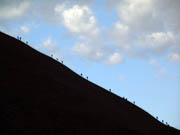 |
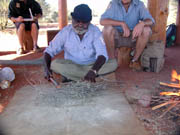 |
We spend the morning on a walking tour of the park led by an
Aborigine guide, learning a little about a way of life thatís long
passed. Then, in the heat of the mid day sun we walk
9.4km
around the Rock. Itís worth the walk, but itís perhaps best done
earlier or later in the day, when the sun is less intense. Iím reminded
of the quote ďmad dogs and Englishmen go out in the noon day sunĒ.
Well, in this case itís ďmad dogs and CanadiansĒ. Later in the day, our
plan to view the sunset over Uluru is cancelled as thunder clouds roll
in. We console ourselves Ė thousands have seen the sunset at Uluru, not
nearly as many have experienced an outback thunderstorm.
|
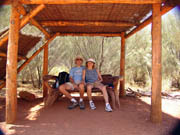 |
Day 8 Ayers Rock to
Alice Springs & Day 9 Alice Springs
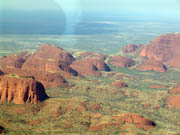 |
Leaving the next day,
we fly around Uluru and the neighboring Olgas before setting out for our
next destination Ė Alice Springs. In Alice Springs we learn more
about two very interesting and unique services available in
Australia, both the result of the vastness of the country.
The Royal Flying Doctors service ensures that residents in all of
Australia, no matter how remote, have emergency medical aid
available. If you are injured or ill, and canít get to a
doctor, the doctor will come to you. |
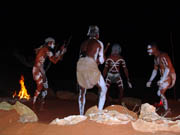 |
|
The School of the Air,
provides education to children growing up in the outback, enabling
them to stay with their families and conduct their studies via
radio (and now the internet) instead of going to boarding school.
We enjoy an
evening at an Aboriginal Cultural Centre listening to the eerie
sounds of the didgeridoo and watching Aboriginal dances.
Kangaroos and wallabies move in the shadows just beyond the light
of the fire.
Pervasive everywhere is the heat, the sun and the lack of water. Next
day our aboriginal guide here shows us how to find water in a dry
riverbed, introduces us to Ďbush tuckerí, Australiaís version of edible
wilds, and gives us a chance to throw a boomerang. That night, after a
glorious sunset, we dine under the stars again, eating steak cooked over
the fire at a remote outstation. |
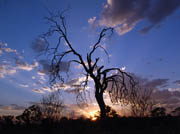 |
Day 10 Alice
Springs to Mt. Isa
 |
Next stop Ė Mt. Isa. Enroute we refuel at a
remote gravel airstrip where the first plane has to chase a wild horse
off the runway. Fuel is hand pumped from the barrels that have been
dropped off for us here. When we land in Mount Isa, the temperature on the
runway hovers around 43C (that's about 110 F). We passengers hide under the plane wings for
shade as the pilots close up the planes. Other than a tour of the huge
lead, silver and copper mine, Mount Isa has little to offer, but itís a
part of the mosaic that is Australia and as such, worth the stop.
|
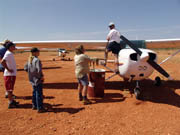 |
Day 11 Mt. Isa to Longreach & Day 12 Long
Reach
|
The next day, we fly through haze and dust to Longreach, the home of
Quantas. On the way, we make a refueling stop at Winton, a tiny
airport. As we stand by the runway and look around, the land
stretches flat and desolate for as far as the eye can see. We joke about
what we would do if we were stranded here. Dry. Dry.
Dry. Have I mentioned that the outback is dry? While running
water into the sink in the small airport bathroom, I notice that a
family of frogs (4 as far as I could tell), desperate for water, have
moved into the sink drain.
|
 |
| Longreach
has the Quantas Museum and the Stockmans Hall of Fame. The most
fascinating of the two is the Stockmanís Hall of Fame. It shows the
history of settlement in Australia and provides short video clips of the
various hardships faced by Australians. The rabbit plague video shows
schoolchildren chasing thousands of rabbits with baseball bats.
Thousands. Really! Iíve heard about Australiaís experience with
rabbits, but until I see the video I really have no idea of the scale of
the problem. Rabbits are just one of the Ďliving plaguesí that have
afflicted Australia, others are swarms of locusts and masses of mice.
Other clips show a sand/dust storm moving in. Amazing. Truly amazing.
I leave with a newfound respect for Australiaís early settlers, and for
those who still live out there in an isolation that Iím only beginning
to imagine.
Another interesting tour in Longreach is the Oakley Station Tour. Our
small bus takes us out to a Ďstationí, the Australian equivalent of a
ranch. The bus slowly rambles around the station, while the owner of
the station shares a little of its past and present. We have the
opportunity to see emus, camels, iguanas and lots and lots of kangaroos
in the wild, as well as an assortment of farm animals. This time the
huge green frog that lives in the guest bathroom sink drain less
surprises me. |
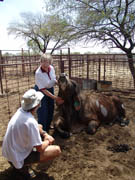 |
Day 13 Longreach to
Hamilton Island & Day 14 and 15 Hamilton Island
|
Australia is not all outback though, and itís time to see the coast.
We fly over a coastal range of mountains, and magically a picture
postcard blue ocean appears before us. The coastline is green, with
pristine, almost white sand beaches. We are heading up to Hamilton
Island, one of the Whitsunday group. At the airport, we are greeted
like dignitaries and our luggage is hustled away. This is another
world. A world of luxury hotels and golf carts (few cars) that hum
quietly as they whisk the tourists from town, to restaurant, to beach,
to hotel. For dinner an all wheel drive vehicle takes us some rough
roads to the other side of the island to a deserted cove for a beachside
dinner and an evening of entertainment. We eat the freshest raw oysters
weíve ever had as we hack them off the rocks. |
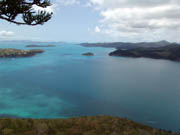 |
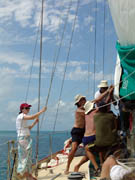 |
Weíve been in the air, and weíve travelled across the land, now itís
time to get out onto the water. We board the Banjo Paterson sailboat for
a day trip to snorkel on a reef and walk on the squeaky white sands of
Whitehaven Beach. After days in the outback and we all enjoy the
proximity of the water as we relax in the sun. Yet another great day. |
Day 16 Hamilton Island
to Brisbane
Our last day of flying takes us down the coast and back to Brisbane. We
fly over endless miles of (almost) deserted beaches, dodging
thunderstorms and showers along the way. Brisbane, the biggest city
weíve seen in 14 days, is so busy that itís a bit of a shock. Itís with
some sadness that I realize our circle tour is complete. Our air safari
is over. Over yes, but weíre not done with Australia yet. Australia is
more than outback and the Whitsundays. How can we go home with out
diving the Great Barrier reef? Without seeing the Blue Mountains or
exploring the wineries of southern Australia? One part of our trip has
ended, but another begins.
Summary
Whatís not to love about Australia? Itís a land of extremes. Itís not
just hot Ė but hot enough to drive the people underground. Itís not just
dry Ė but dry enough for people to fire explosives into the sky to make
rain and for frogs to move into sink drains. Elsewhere there are
rainforests and snow topped mountains on which people ski. I was
looking for something different. Australia did not disappoint. This
was a wonderful trip and a wonderful way to see this fascinating
country.
Sky Bicevskis
|